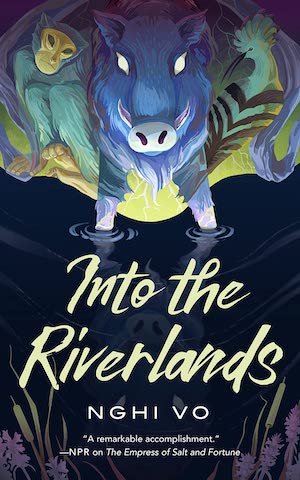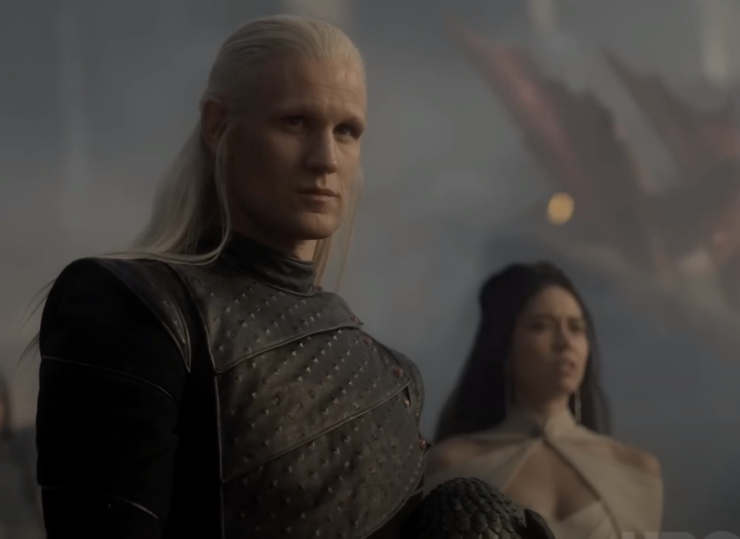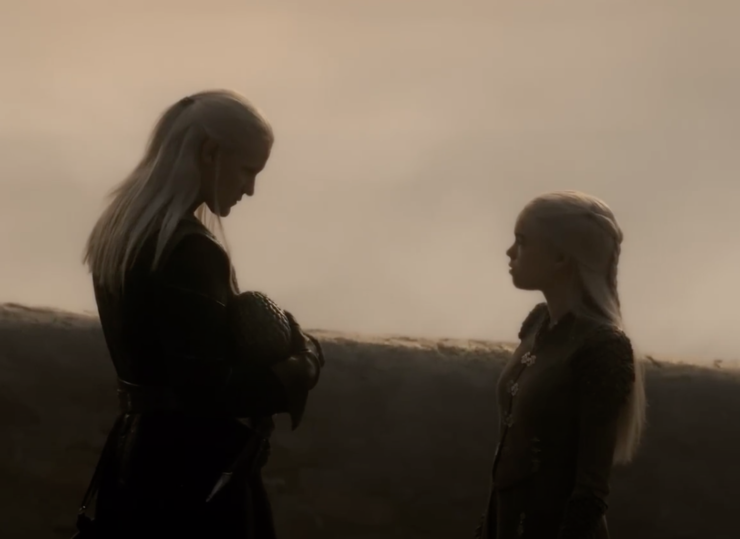Welcome back to our ongoing discussion of House of the Dragon! Tor.com has been kind enough to let me spend this inaugural season doing a bit of a deep dive into some of Martin’s lore and how the show deviates from, builds off of, and informs our understanding of Fire & Blood, the history of House Targaryen, and the fate of the Iron Throne. Having been reading and re-reading books about Westeros on and off for the last twenty two years, I’m excited to see how this next chapter of the Game of Thrones saga brings more of the world of A Song of Ice and Fire to life, and there are plenty of key references and history to dig into in Episode 2, “The Rogue Prince.”
A Game of Fire and Blood
First of all, we have our new title sequence! It’s somewhat surprised to hear Ramin Djawadi’s opening theme from the original series and not a riff on it, but the visuals provide some new bits of intricate visual storytelling. Done in the same game-board style of the original series, these new titles move us through a stone model of the ancient city of Valyria—similar to the one that King Viserys (Paddy Considine) agonizes over in his chamber. The camera weaves throughout the increasingly Escher-esque model as first a trickle, then a rivulet, then a veritable torrent of blood flows through game-pieces and past murals depicting significant moments of Targaryen history in Westeros. I can give you a rundown of the major moments I spotted, though a few remain opaque to me:
Buy the Book


Into the Riverlands
- The sequence begins with a game-piece depicting the Doom of Valyria with golden dragons and a cracked, black cityscape consumed by silver flames. The Doom, which was referenced in the first episode as well as throughout the original series, is Martin’s analogue of the sinking of Atlantis, where the Fourteen Flames (the volcanoes that dotted the Valyrian peninsula in Essos) erupted at once, shattering the landmass and wiping out all of Valyria proper save the Targaryens, Velaryons, and a few scattered descendants in the Free Cities (then colonies of the Freehold).
- The blood then runs down past a bas-relief depicting what appears to be the Field of Fire–the most decisive battle of Aegon I’s conquest of Westeros. It was the only time during the conquest that Aegon and his two sister-wives Rhaenys (the namesake of House of the Dragon’s “Queen that Never Was”) and Visenya all rode their dragons (Balerion the Black Dread, Meraxes, and Vhagar—more on her later) into battle, immolating the armies of King Loren Lannister of the Westerlands and King Mern Gardener of the Reach. While there would be other important battles during the conquest, the one that extinguished the line of Gardener kings and brought about the surrender of the Lannisters is why most Westerosi lords refuse to challenge the might of the Targaryen dynasty outright.
- The blood rushes by a game-piece showing a dragon with a spear through its eye. I am fairly certain this represents the death of the dragon Meraxes and her rider, Aegon I’s beloved Queen Rhaenys at the hands of a Dornish scorpion bolt. The death of the Queen and her dragon were signs of the Targaryen dynasty’s inability to conquer Dorne which remained “unbowed, unbent, and unbroken” even when, one hundred and eighty seven years after Aegon began his conquest, the last of the seven kingdoms was brought under Targaryen rule through marriage rather than military campaign.
- The blood then passes by a game piece with the Targaryen crown and another whose symbol is unclear to me before splitting into nine separate streams. This mostly likely represents the progeny of Jaehaerys I (Michael Carter) and Good Queen Alysanne who had nine children survive to adulthood and produce the succession crisis depicted in the opening scene of the previous episode. We can see the blood flowing across the walls and ceiling, as the ramifications of naming Jaehaerys’ most direct male relative as his heir cause fractures and doubts that are still very much at play during the timeline of the show.
- One of these streams passes by another Targaryen crown and the Moon and Falcon sigil of House Arryn—representing King Viserys and the now deceased Queen Aemma (an Arryn daughter).
- The blood coalesces around three interlinked loops of Valyrian steel—perhaps standing in for Rhaenyra and the necklace she was given by her profligate uncle Daemon in the first episode.
- The blood flows past a mural of a dragon rampant over a number of sigils of Westerosi lords including the Lannister lion, Baratheon Stag, the Tower of Hightower, and perhaps the seashells of House Westerling (bringing to mind Ser Harrold Westerling of the Kingsguard, played in House of the Dragon by Outlander and The Hobbit’s Graham McTavish).
- The opening titles end with the various rivers of blood emptying into a fiery pit over which floats the three-headed dragon of House Targaryen.
You can watch the whole sequence here:
There is a lot to unpack here. On an obvious level, the blood is a reference both to royal blood (which is passed from monarch to heir and is spilled in violent conflict) and to the Targaryen house motto, “Fire and Blood.” The blood in that phrase is in reference to the blood of Old Valyria which sets the Targaryens apart as slightly inhuman—the last scions of a dead civilization far more advanced than any others in the known world.
That Valyrian blood is also the basis for the Doctrine of Exceptionalism—an article of the Faith of the Seven that holds that, because of their origins in Valyria, with different roots, heritage, practices, and traditions that set them apart—Targaryens are allowed to practice sibling and close-cousin incest as a way of keeping their all but extinct bloodline pure. Martin explains in Fire & Blood that the doctrine is the result of a hard-won Targaryen charm offensive against a church rightly horrified by practice but that it results in an enduring perception that the Targaryens are, in the words of Rhaenyra, “more like gods than men.” The original series got away with focusing on incest through the Lannister twins, Jaime and Cersei, who assured one another that they had a right to the practice because the Targaryens had paved the way for it. But while their affair is painted as a liability to their reputation (and their children are illegitimate heirs as a result of it), during the events of House of the Dragon the Doctrine of Exceptionalism is very much still in play. This series is going to have an uphill battle selling us on a world where Targaryens are exempt from the incest taboo as a result of their magical heritage.
Finally, the blood of Old Valyria is not just symbolic of a lost heritage. Martin often describes the Valyrians as having dabbled in blood-magic, even going so far as to have characters suggest that practicing forbidden arts led to the Doom itself. In Game of Thrones, the Targaryens are an all but extinct line who the majority of characters on the show remember only for a horrific legacy of madness and destruction. In House of the Dragon, the Targaryens are at the height of their power and the links to Valyria are ever present. Viserys I’s model of the city is a major focal point of this second episode and having the opening titles show the blood of the dragon moving through that model reminds the viewer that Valyria was only destroyed about two centuries prior and its blood magic, dragon-mastery, and wonders aren’t so very remote in this era.

Dragonlore
Finally, this series is not just about Targaryens but about the dragons they ride, and “The Rogue Prince” gives us some insights into how they operate. While Viserys speaks with Laena Velaryon (Savannah Steyn) in a wildly uncomfortable interview as he considers a future marriage, she mentions that Viserys was the last person to ride Balerion, the Black Dread before he died. In turn, Viserys explains that Balerion was the last living creature who remembered Valyria before the Doom. Martin has Archmaester Gyldayne chronicle this in Fire & Blood, making Viserys himself the last tenuous link to Old Valyria and a sort of endpoint for Targaryen exceptionalism. Balerion (along with Vhagar, Meraxes, and Syrax) was named for a Valyrian god and his skull is shown on House of the Dragon as a sort of cult object, appearing in the previous episode surrounded by candles as Viserys tells Rhaenyra about Aegon’s Dream of Ice and Fire.
This mystical, worshipful attitude is a recurring theme in Martin’s books as dragons are continually shown to be something more supernatural and strange than simply large, fire-breathing reptiles. Martin implies psychic bonds between a dragon and its rider. They also have unnatural births. This episode hints at that with the Dragonkeepers quickly taking Dreamfyre’s stolen egg from Rhaeynra and placing it in a hot brazier. Dragon eggs are hatched with fire magic and often with sacrifice (more fire and blood). In the original series, Daenerys’ three eggs are old enough to have been fossilized but hatch when she places them on Khal Drogo’s funeral pyre. This series seems more than willing to engage with the occult weirdness of Martin’s dragon lore, something I am very much here for…
The aforementioned conversation between Viserys and Laena also references Vhagar, whom the showrunners have (delightfully) chosen to make the subject of a bit of a mystery. Laena intimates that Vhagar is missing, being too large and uncontrollable for the Dragonpit. Viserys tells us that the Dragonkeepers believe she has made a nest somewhere on the coast of the Narrow Sea. Fire and Blood is told from Archmaester Gyldayn’s bird’s-eye view and that book often lacks the specifics and details that this show seems more than willing to fill in. In this particular case the intractability and prodigal nature of the last of the dragons of Aegon’s Conquest feels like a perfect set up to have her reappear at a spectacular, opportune moment (perhaps during the War for the Stepstones that seems to be teased on the next episode). Viserys also suggests that dragons get lonely. This inscrutability and inability to read their moods (as both animals and strange magical portents) is one of the hallmarks of Martin’s take on dragons and something that will hopefully be explored in detail in this series.
That’s it for this week. So much more to talk about as the series progresses. The tease of Craghas Drahar, the Crabfeeder, and his absolutely wild costume design is sure to be a fascinating point going forward. What other details struck you in this week’s episode, and what are you hoping to see as the season continues to unfold?
Tyler Dean is a professor of Victorian Gothic Literature. He holds a doctorate from the University of California Irvine and teaches at a handful of Southern California colleges. He is one half of the Lincoln & Welles podcast available on itunes or through your favorite podcatcher. His fantastical bestiary can be found on Facebook at @presumptivebestiary and his article “Exhuming M. Paul: Carmen Maria Machado and Creating Space for Pedagogical Discomfort” is forthcoming in Victorian Studies.










